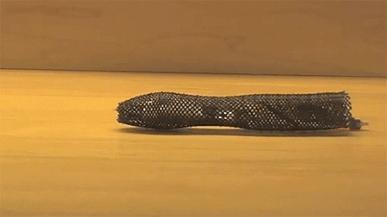

Below a certain temperature, the alloy shifts to a martensite phase - a more pliable structure that, like a paperclip, stays in the shape in which it’s bent. Above a certain temperature, the alloy remains in a phase called austenite - a regularly aligned structure that springs back to its original shape, even after significant bending, much like flexible eyeglass frames. “Depending on the ratio, its behavior changes dramatically.”ĭepending on the ratio of nickel to titanium, the alloy changes phase with heat. “It’s a very bizarre material,” Kim says. They then looked for ways to create artificial muscle, ultimately settling on a nickel-titanium alloy. The mesh, made from interlacing polymer fibers, allows the tube to stretch and contract, similar to a spring. The researchers first made a long, tubular body by rolling up and heat-sealing a sheet of polymer mesh.

The team set out to design a similar soft, peristalsis-driven system. Both muscle groups work together to inch the worm along. They noted that the creepy crawler is made up of two main muscle groups: circular muscle fibers that wrap around the worm’s tubelike body, and longitudinal muscle fibers that run along its length. Instead, Kim and his colleagues looked to the earthworm for design guidance. “Integrating micro air compressors into a small autonomous robot is a challenge,” Kim says.Īrtificial muscle from a bizarre material But Kim says air-powered, or pneumatic, robots require bulky pumps. One solution has been to use compressed air, carefully pumped through a robot to move it. Their pliable exteriors also make them safe for human interaction.Ī significant challenge in soft robotics has been in designing soft actuators, or motors, to power such robots. Without bulky, breakable hardware, soft robots might be able to explore hard-to-reach spaces and traverse bumpy terrain. In the past few decades, many roboticists have looked for ways to engineer soft robotic systems. Wood at Harvard, assistant professor Kyu-Jin Cho PhD ’07 of Seoul National University, and Daniela Rus, professor of computer science and engineering and director of MIT’s Computer Science and Artificial Intelligence Laboratory (CSAIL). In addition to Kim, the paper’s authors are graduate student Sangok Seok and postdoc Cagdas Denizel Onal at MIT, associate professor Robert J. The team recently published details of the design in the journal IEEE/ASME Transactions on Mechatronics. They then applied a small current to the segments of wire, squeezing the mesh tube and propelling the robot forward. They wound the wire around the tube, creating segments along its length, much like the segments of an earthworm. Researchers created “artificial muscle” from wire made of nickel and titanium - a shape-memory alloy that stretches and contracts with heat. The robot is named “Meshworm” for the flexible, meshlike tube that makes up its body.

Edgerton Assistant Professor of Mechanical Engineering at MIT, says such a soft robot may be useful for navigating rough terrain or squeezing through tight spaces. The robot, made almost entirely of soft materials, is remarkably resilient: Even when stepped upon or bludgeoned with a hammer, the robot is able to inch away, unscathed. Now researchers at MIT, Harvard University and Seoul National University have engineered a soft autonomous robot that moves via peristalsis, crawling across surfaces by contracting segments of its body, much like an earthworm. Snails and sea cucumbers also use this mechanism, called peristalsis, to get around, and our own gastrointestinal tracts operate by a similar action, squeezing muscles along the esophagus to push food to the stomach. SpongeBob then tries to grab the key from the worm when the toddler escapes until he realizes he can simply go right through the prison bars.Earthworms creep along the ground by alternately squeezing and stretching muscles along the length of their bodies, inching forward with each wave of contractions. It constantly just stares at the animatronic prisoners while they try to get the worm to trade the prison key in his mouth for either a bone or a leash. It is one of the many animatronics in Glove World! Jail. It holds a golden prison key in its mouth. It is a small light green robot worm with yellow eyes and black pupils. The animatronic guard worm is a robot worm who appears in the episode " Escape from Beneath Glove World." " Escape from Beneath Glove World" List of characters


 0 kommentar(er)
0 kommentar(er)
